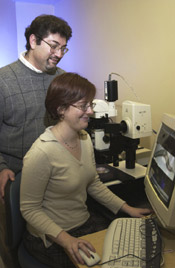
TUSCALOOSA, Ala. – A creature with exactly 302 neurons seems an unlikely stand-in for the human brain, when has more than 100 billion neurons. Yet C. elegans, a nematode no bigger than the comma after this clause, may be a new model for epileptic seizures in humans, according to researchers at The University of Alabama.
UA scientists and students working in the laboratory of Dr. Guy Caldwell, assistant professor of biology in UA’s College of Arts and Sciences, are investigating the molecular basis of a devastating human brain malformation called lissencephaly, which has been traced to a gene called LIS-1. Children born with lissencephaly have severe mental retardation and frequent epileptic seizures.
“We can now create worms that have epileptic seizures in our lab,” said Caldwell. “If we can deduce the specific defect, hopefully we can go in and find things that will cure it, either genetically or chemically.”
UA graduate student Shelli Williams has identified worms with the mutated lis-1 gene, through research supported by Caldwell’s National Science Foundation Career Award and his Basil O’Connor Scholar Award from the March of Dimes. She will present the latest research findings during the American Society For Cell Biology’s annual meeting in San Francisco Dec. 13-17.
The UA research is one of 13 research stories that will be published in ASCB’s press book, “Cell Biology 2003.” It was selected from 1,340 abstracts screened for the book that will be distributed at the international meeting of some 10,000 researchers.
When LIS-1 is altered in humans, neurons fail to migrate properly during brain development, resulting in the characteristic smooth appearance of the cerebral cortex found in children born with lissencephaly. While only one in 30,000 live births results in a child with lissencephaly, epileptic seizures affect roughly 2 percent of the adult population and are poorly understood.
Research into a rare disorder often leads to insight into more common diseases, Caldwell said.
The human gene, LIS-1, has an analog in C. elegans, worm lis-1. Indeed C. elegans shares roughly half its genes with humans. Each worm has only 302 neurons, which operate in much the same way as human neurons using ion channels and neurotransmitters, like dopamine, serotonin and GABA.
In Williams’ work, the loss of lis-1 function caused cytoskeletal defects that were lethal to large numbers of young C. elegans. However, some “lissencephalic” worms survive to adulthood, and experience epileptic-like convulsions when exposed to seizure-inducing drugs.
Caldwell and colleagues say these convulsions mimic those seen in other worms with defects in the production of GABA, the most abundant inhibitory neurotransmitter in humans. In addition to seeing GABA-like convulsions in the lis-1 mutant worms, researchers found that transport vesicles containing GABA were mislocalized in neurons of lis-1 mutant worms.
Defects in a protein called dynein, a type of molecular motor that drags GABA-containing vesicles to their proper destinations in neurons, were previously also linked to lissencephaly. Caldwell hypothesizes that lis-1 contributes to the function of this motor, and his lab is currently in hot pursuit of further dynein connections to seizures.
Searching for new genetic links to epilepsy is much easier to do in C. elegans than people, said Caldwell. Although worms are small creatures, scientists can apply powerful methods to rapidly identify genes and pathways associated with aberrant neuronal activity.
Cody Locke, an undergraduate biology student and winner of the 2003 Benjamin Cummings Award, is assisting Williams in the studies and is a co-author on the abstract she will present.
The College of Arts and Sciences is the University’s largest division and the largest public liberal arts college in the state, with approximately 5,500 undergraduates and 1,000 graduate students. The College has received national recognition for academic excellence, and the College’s students have been selected for many of the nation’s top academic honors, including 13 Rhodes Scholarships, 14 Goldwater Scholarships, seven Truman Scholarships, and 15 memberships on USA Today’s Academic All-American teams.
Contact
Chris Bryant, Assistant Director of Media Relations, 205/348-8323, cbryant@ur.ua.eduCathy Andreen, Director of Media Relations, 205/348-8322, candreen@ur.ua.edu
Source
Dr. Guy Caldwell, 205/348-9926Shelli Williams, 205/348-9993